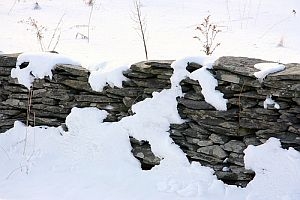
(Host) Old stone walls have been around the Northeast for four centuries; marking the boundaries of old farmsteads and keeping sheep and cows from wandering too far. A number of states are considering legislation to preserve this slice of history. As part of a collaboration with Northeast public radio stations, VPR’s Jane Lindholm reports.
(Lindholm) 87 year-old Robert Jackson was born in the same house as his father, on a 19th century farmstead in Westford, Vermont. An old stone wall marks its boundary.
(Jackson) "It goes beyond the school, corners, over the hill, corners again between the meadow and the woods, and then runs all the way back, and then ends at a swampy area. They must have been at it for years!"
(Lindholm) According to a local history book the wall was built over several winters in the early 1800s. Horses or oxen pulled the heavier stones from nearby fields on sleds, gliding over the snow.
This old wall has endured a lot in its lifetime. In the 1940s an errant car pushed a piece of it sideways. Elm tree roots have had their way with it. And kids from the school next door used to kick out stones while climbing on it-until Jackson put a stop to that. One time he even caught someone who had pulled over on the side of the road…to steal stones.
(Jackson) "First I thought well, probably having a call of nature. Then when he went down and back up again and down again I said uh-oh, I guess I’d better go up there and see what’s going on!"
(Lindholm) The guy took off, but Jackson got his license plate number and called the police, and got his stones back. Now, Jackson has been working with a local stonemason to repair his time-ravaged wall.
(Jackson) "Why do you do it now? It makes you feel good, that gee, that looks so much better."
(Lindholm) And he wants to leave it intact for future generations.
University of Connecticut geologist and stone wall researcher Robert Thorson says there’s a renewed interest in preserving stone walls.
(Thorson) "It’s not just sentimentality. It’s a desire to actually go back and be part of an earlier era where it wasn’t an exit-ramp culture."
(Lindholm) Thorson says people want to feel a connection to their landscape, not just watch it whiz by through a car window.
He says stone walls are found in New England and parts of New York east of the Hudson River, which share a similar geology. These rocks tend to be crunched up, hard-like granite. Hard rock, glacial soil, and a livestock culture promoted stone-wall construction. Thousands were built in the 18th and 19th centuries. And now, Thorson says, many towns and cities are working to preserve them.
(Thorson) "There are special protections but there’s a patchwork of them, depending on what town you’re in, whether you’re on a scenic road, whether you’re in a federal park. It varies."
(Lindholm) As for state laws, Rhode Island passed one in 2001 making it a violation to tear down a historic wall on someone else’s property. Massachusetts is working to increase the fine for damaging old walls from ten dollars to 500. New Hampshire, Vermont, and Connecticut are all considering legislation to preserve walls either through fines or through tax incentive programs.
Meanwhile individual interest in learning how to build a traditional wall is on the rise.
(MacMartin) "Why don’t you just say a word about where you’re from-if you have some walling experience that would be great to know about…"
(Lindholm) On a frigid Saturday morning in Hinesburg, Vermont, eight people gathered in a greenhouse to learn the art of building stone walls. Instructor Charlie MacMartin says without mortar only gravity and friction hold the stones together.
(MacMartin) "We really look for stones that have some kind of rectangular aspect to them. It’s a little bit like playing chess; you’re kind of trying to think a couple of moves ahead as you’re placing stones."
(Lindholm) This is the third winter MacMartin and his partner have been leading the workshops. And they attract all sorts. This workshop had a retiree moving in from New Jersey, a guy in his 20s who likes the puzzle aspect of building, a couple of landscape gardeners, and a man whose wife bought him the workshop so he would stop building crumbling walls all over their property.
MacMartin says he never imagined there would be so many people willing to lay down 100 bucks to learn how to build a wall.
(MacMartin) "The interest has been overwhelming. I mean, I doubled the number of workshops this year and we still have a waiting list of 30 people."
(Lindholm) By the time these homeowners have paid for the workshop, bought stones and spent hours creating their walls, it’ll have cost them more than if they had hired a stone mason.
But they say that’s not the point. To build with stone is to create a lasting monument, to leave a piece of yourself-however small-on the landscape.
For VPR News, I’m Jane Lindholm.
(Host) Northeast environmental coverage is part of NPR’s Local News Initiative. The reporting is made possible, in part, by a grant from United Technologies.